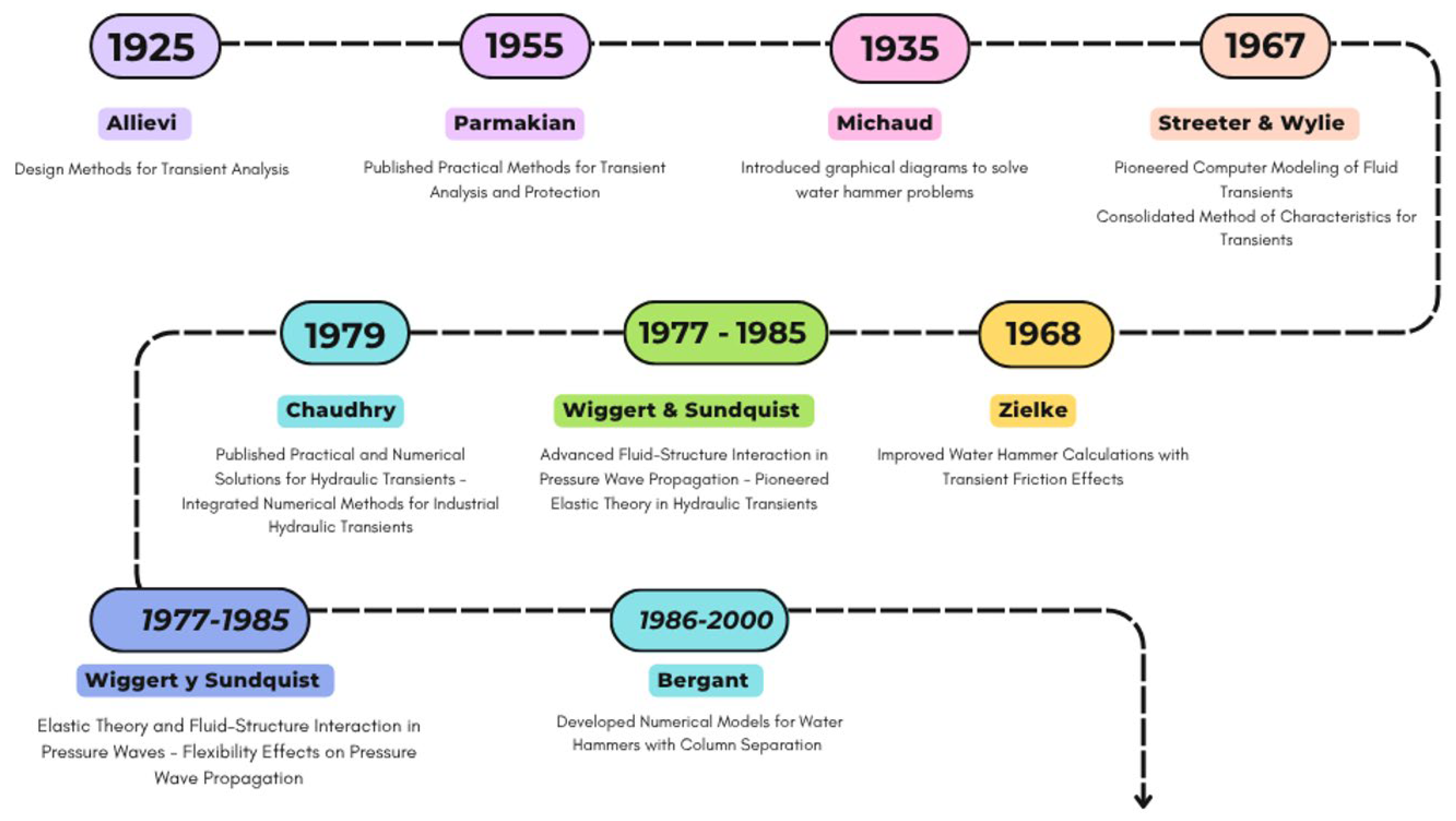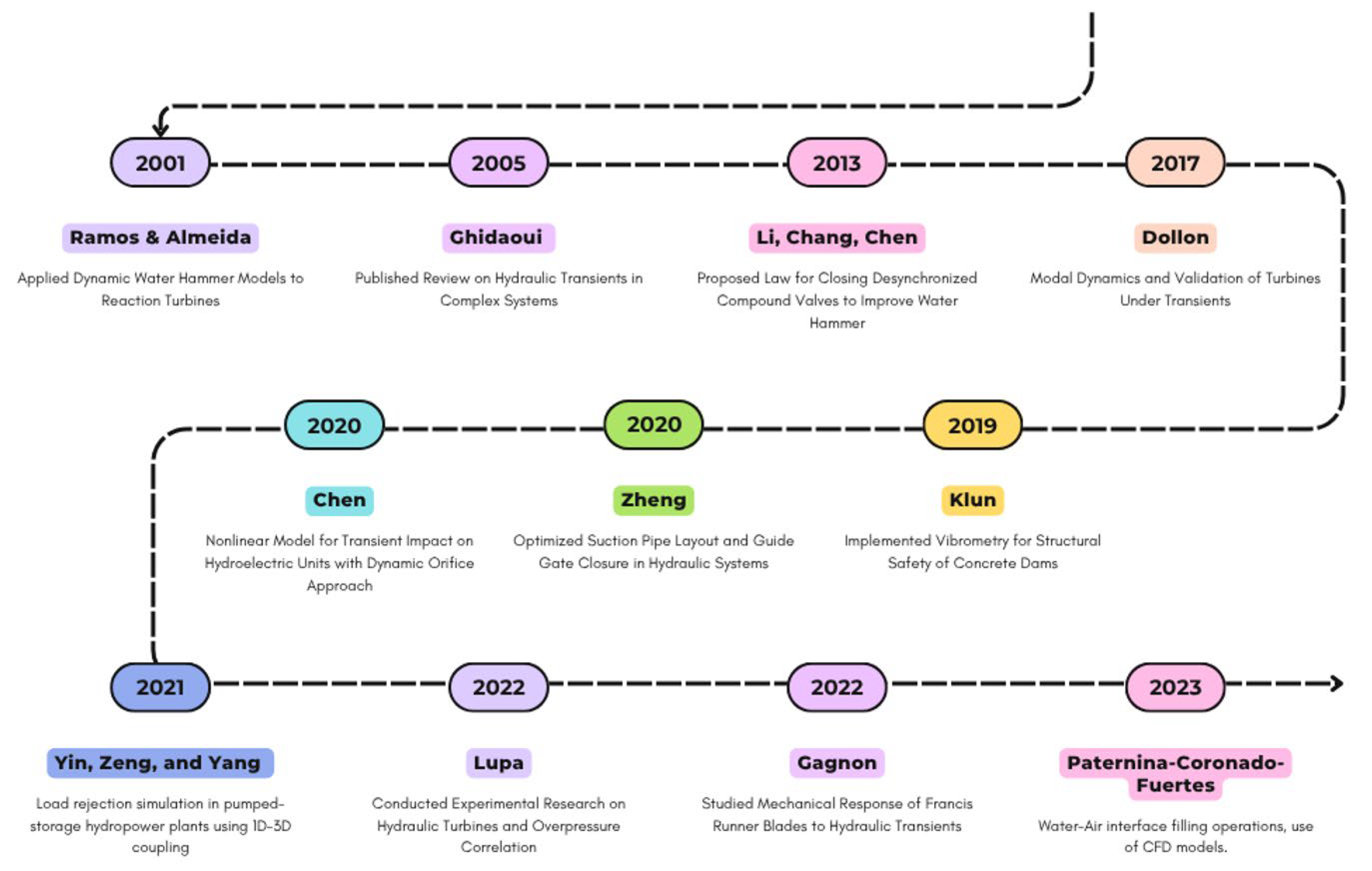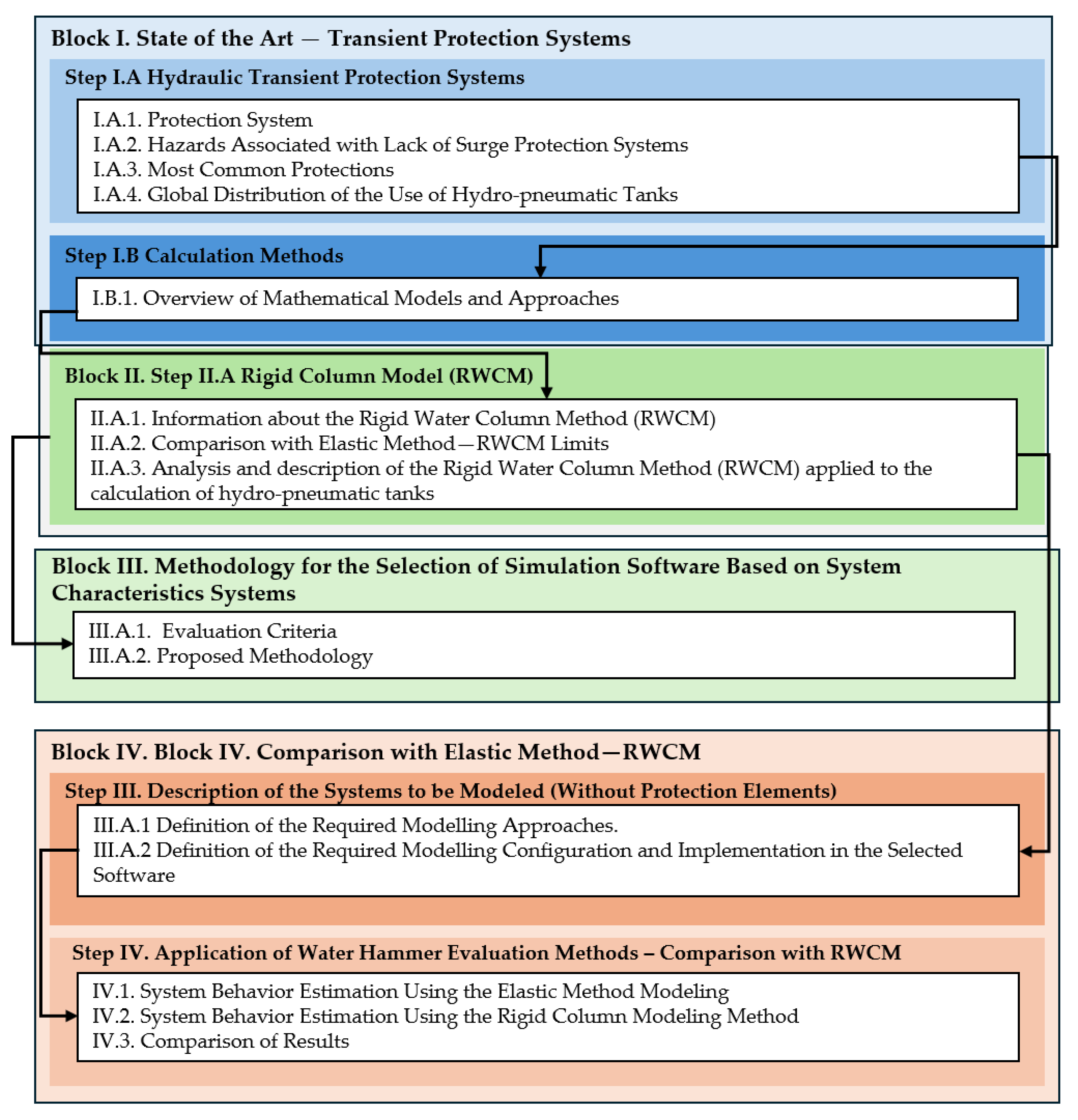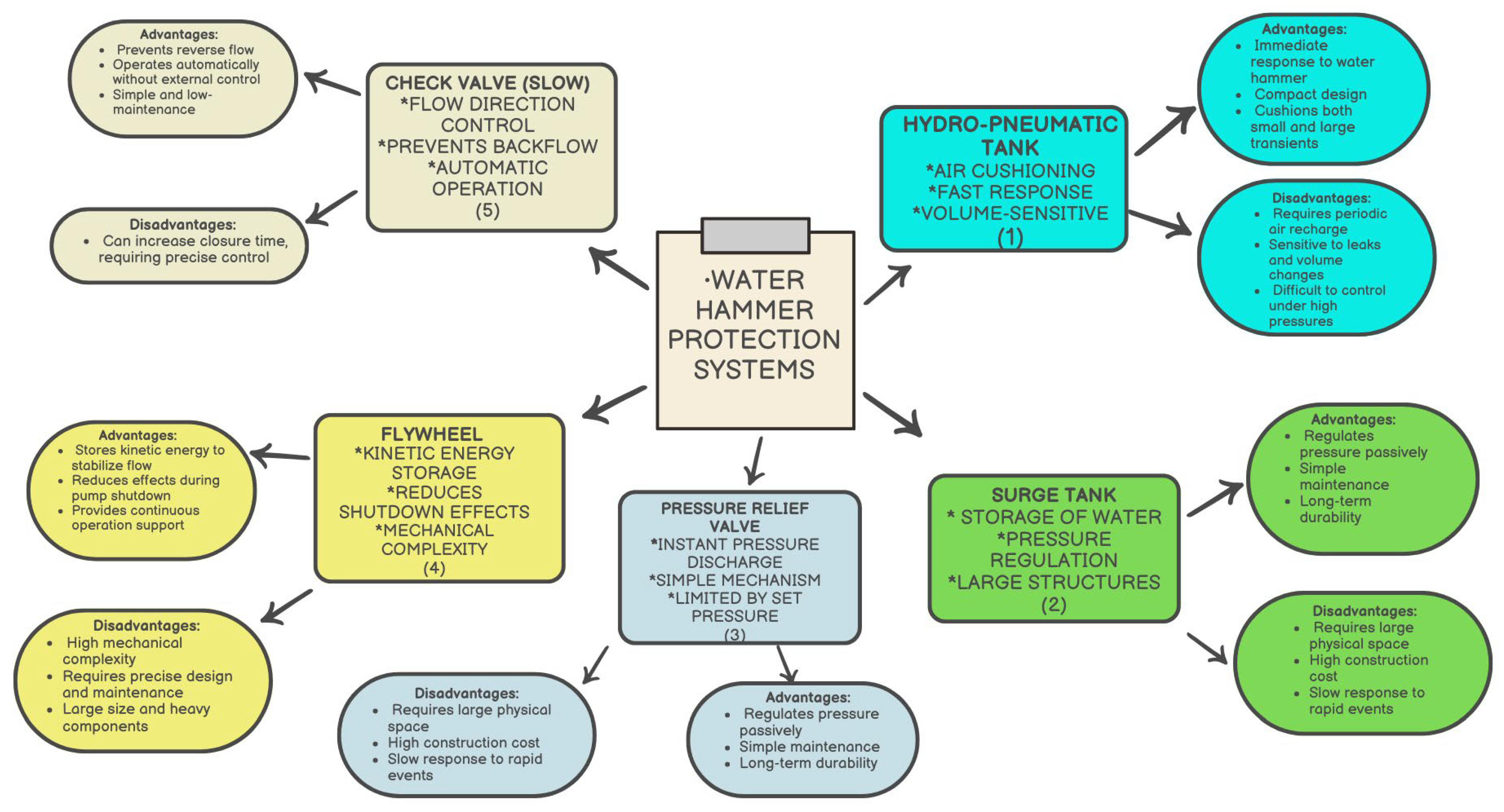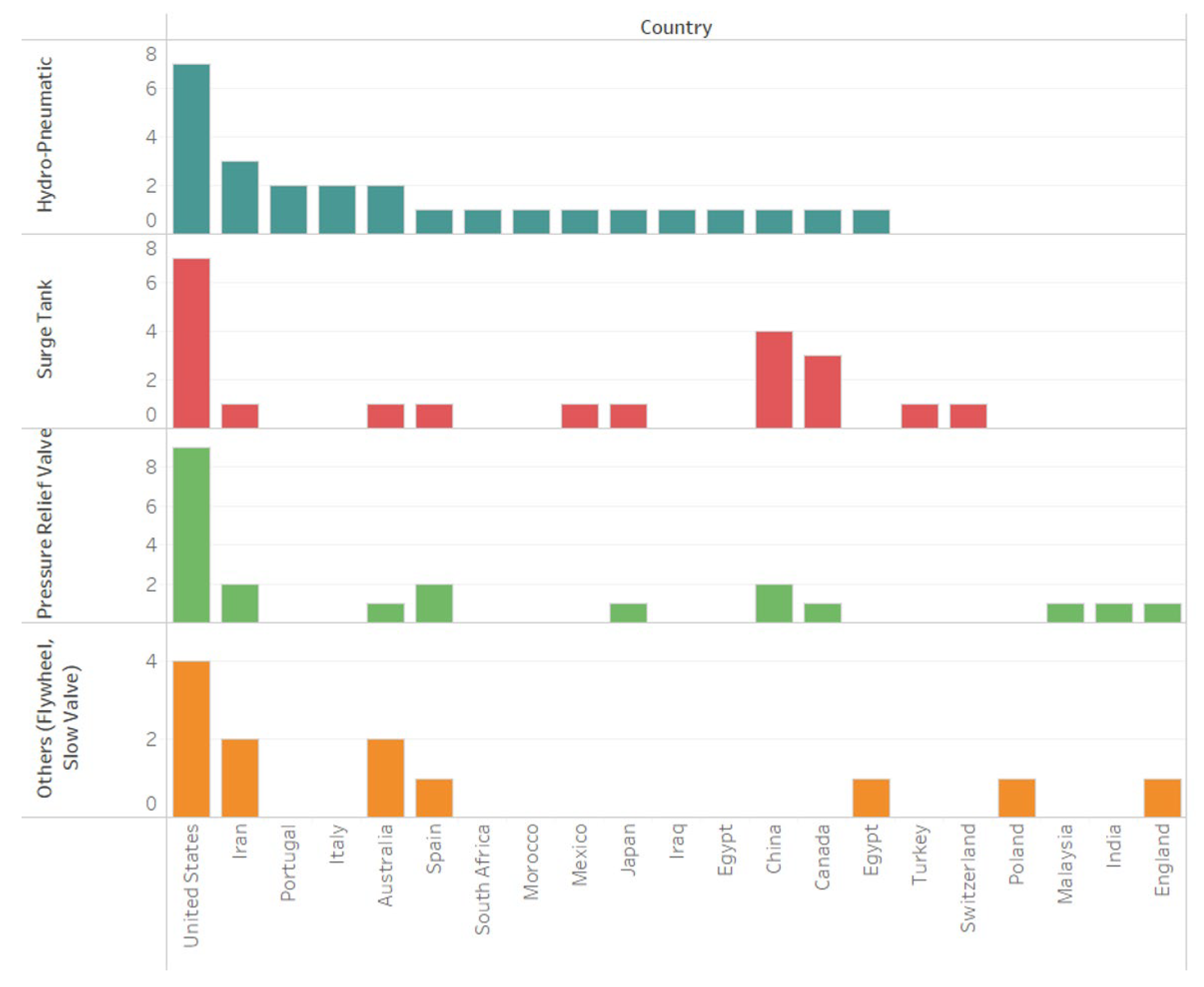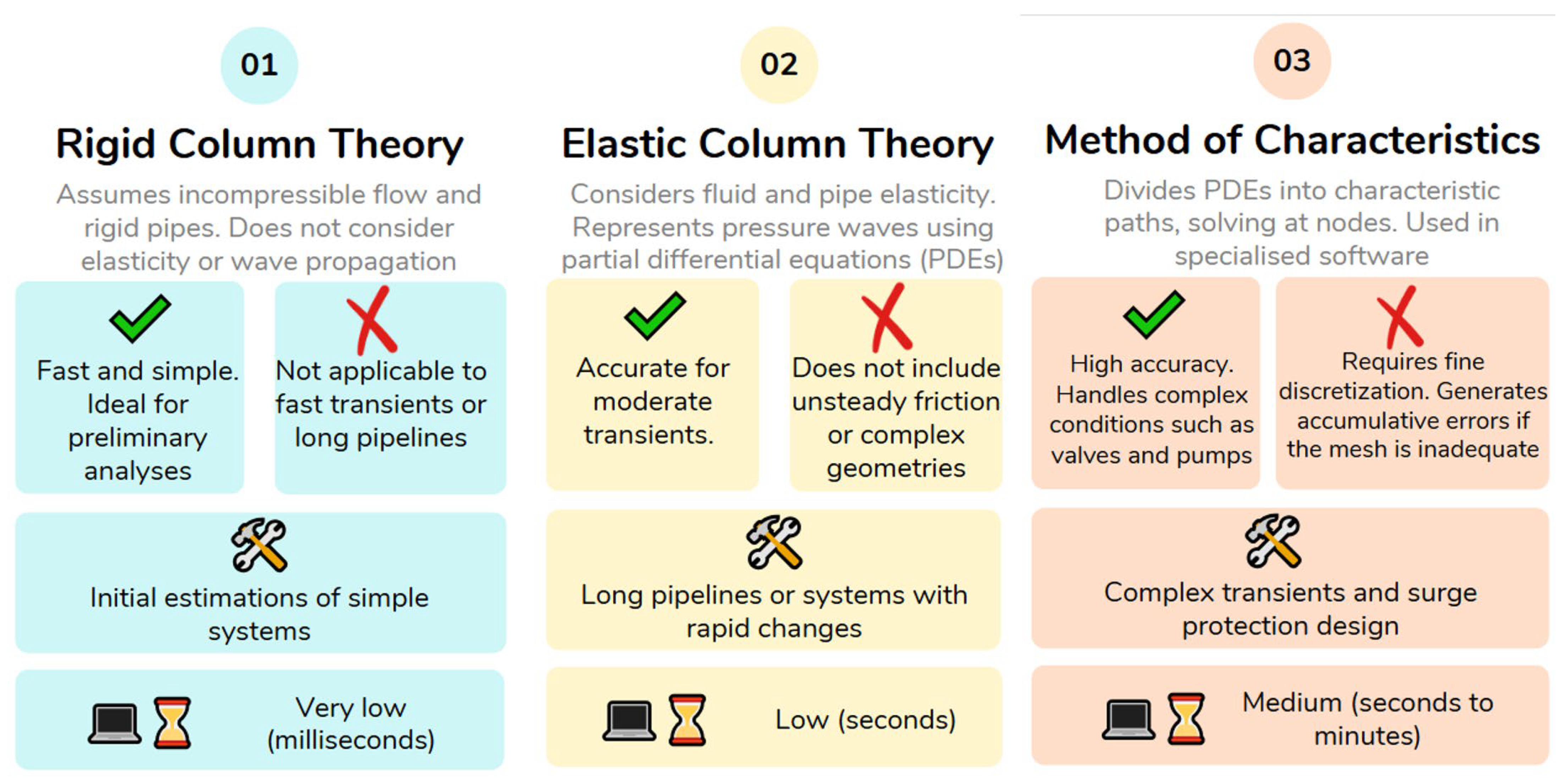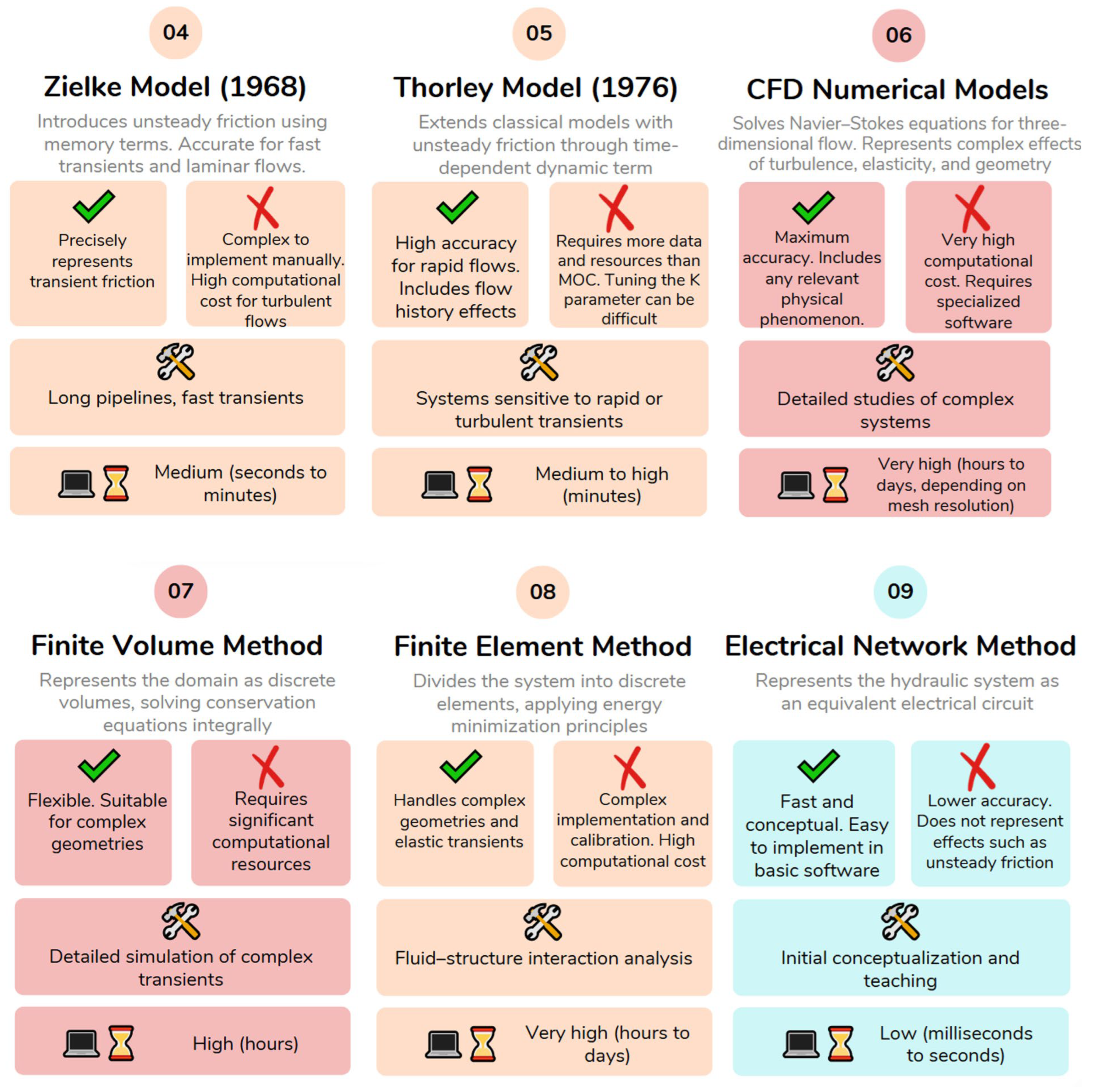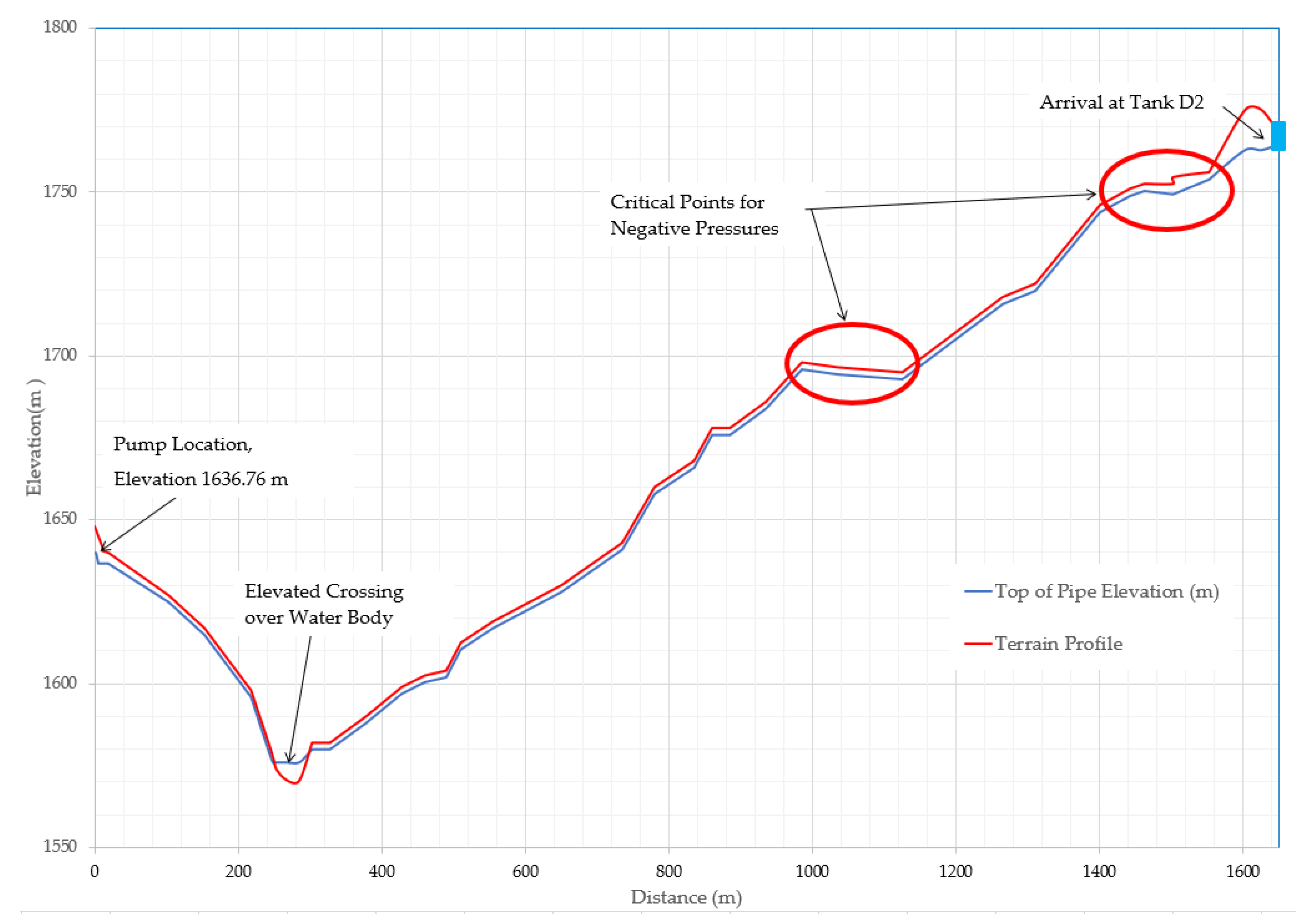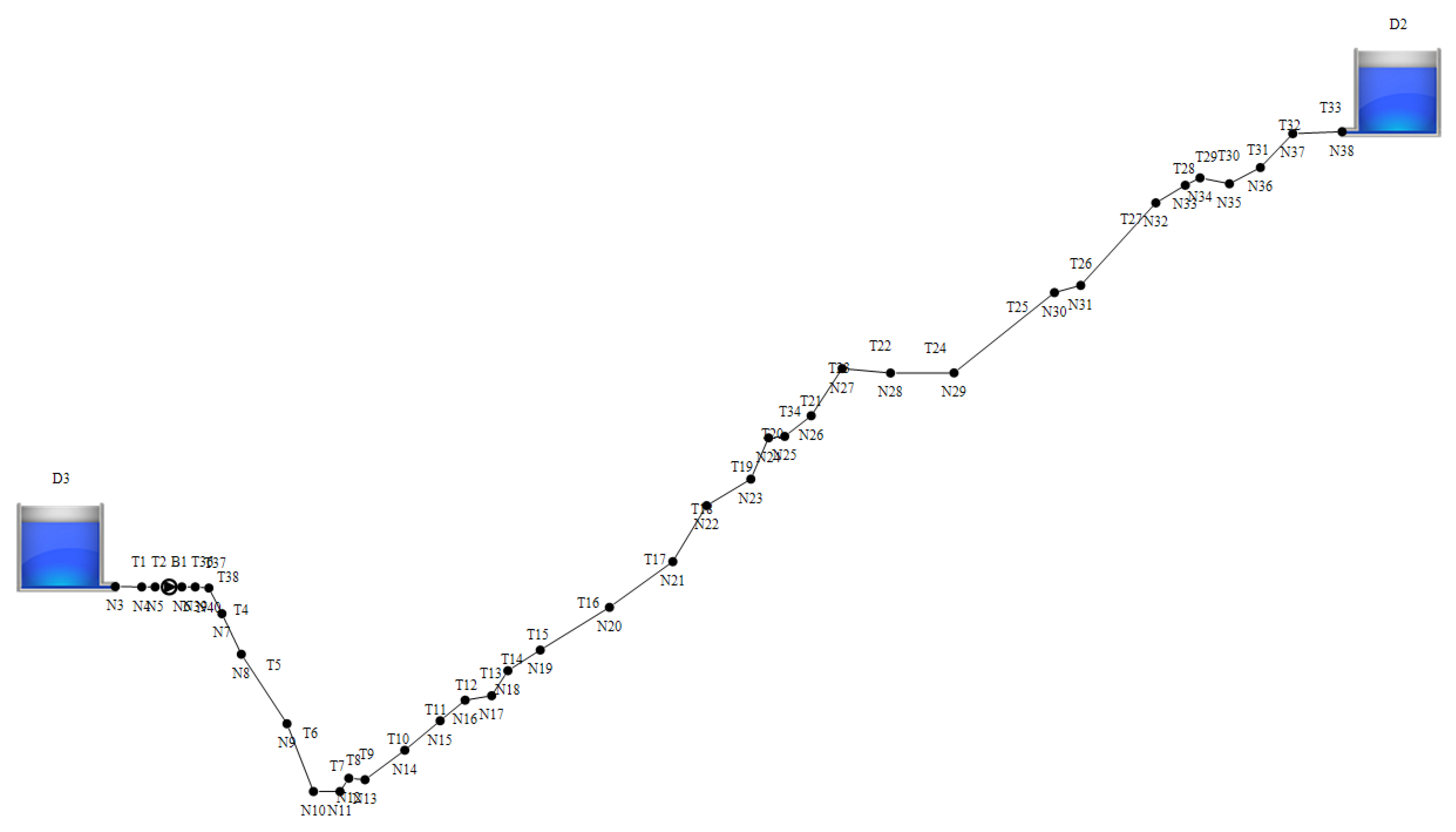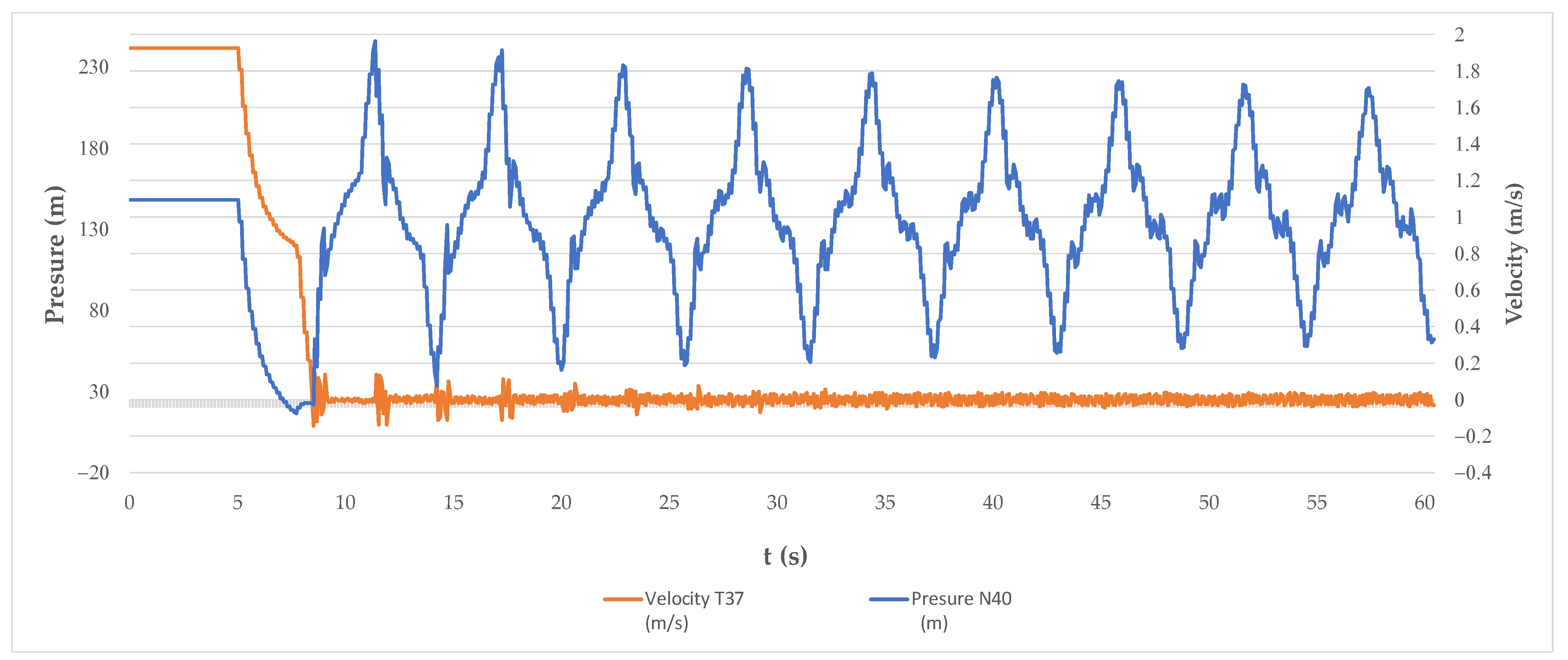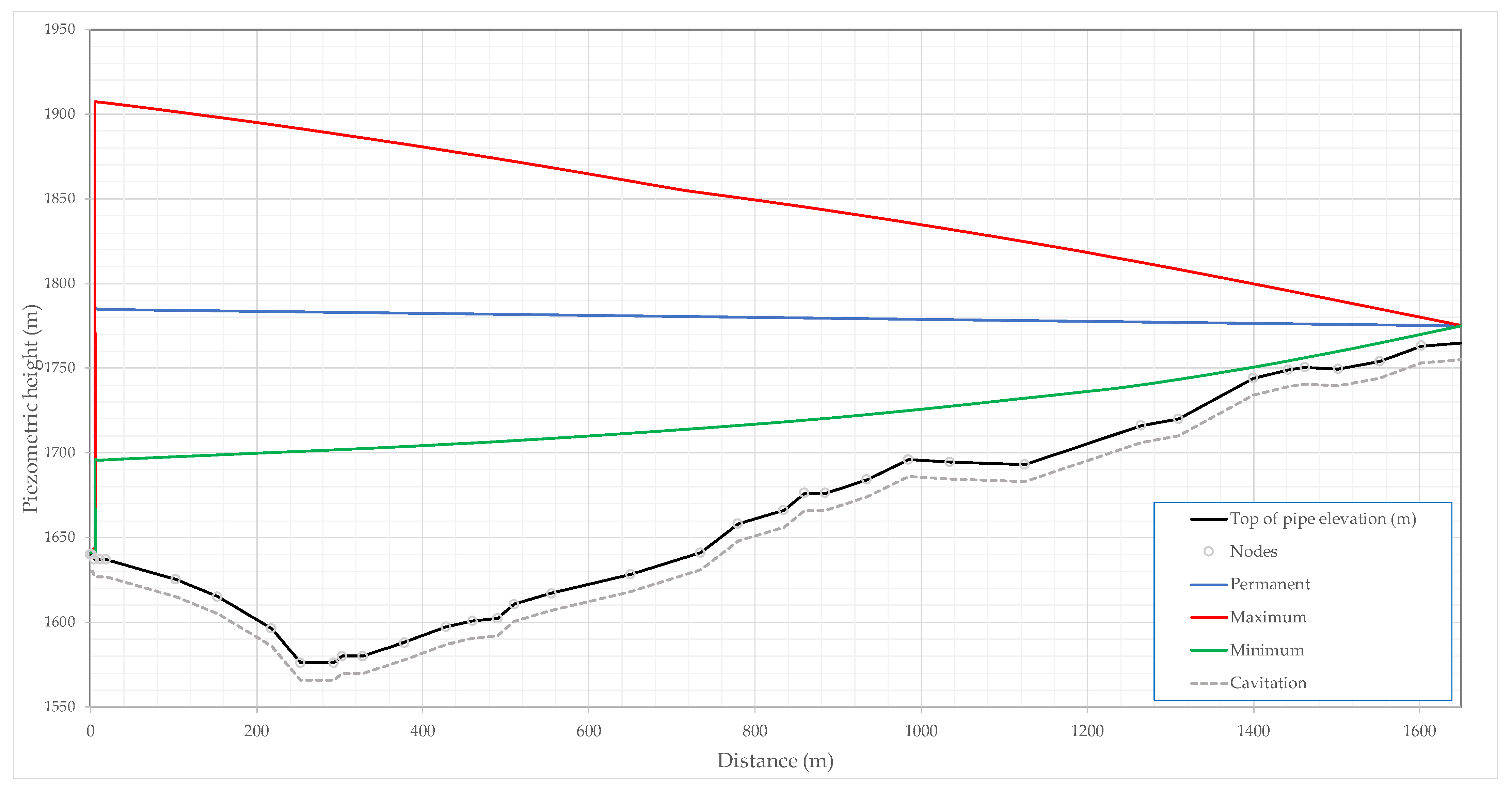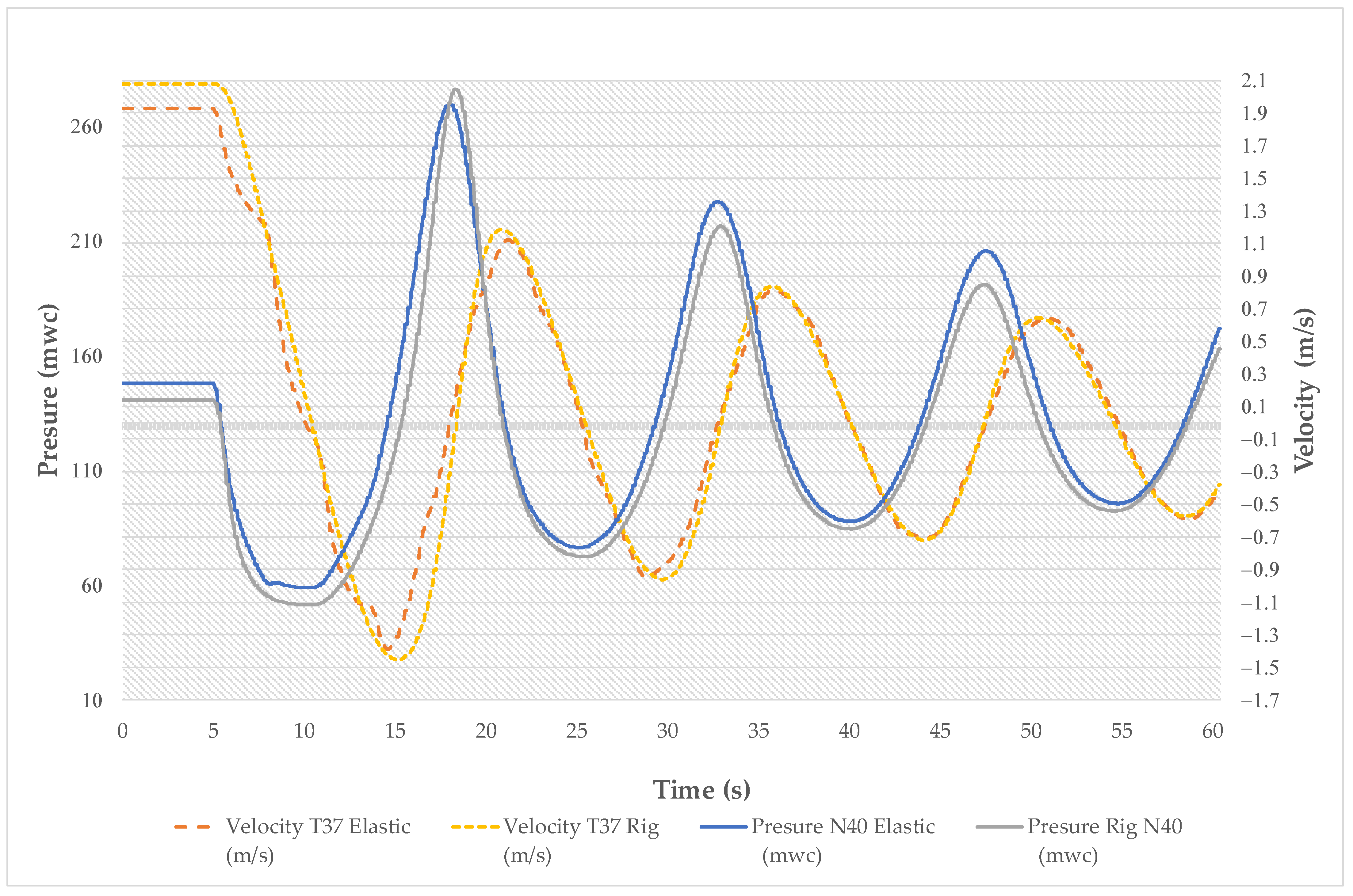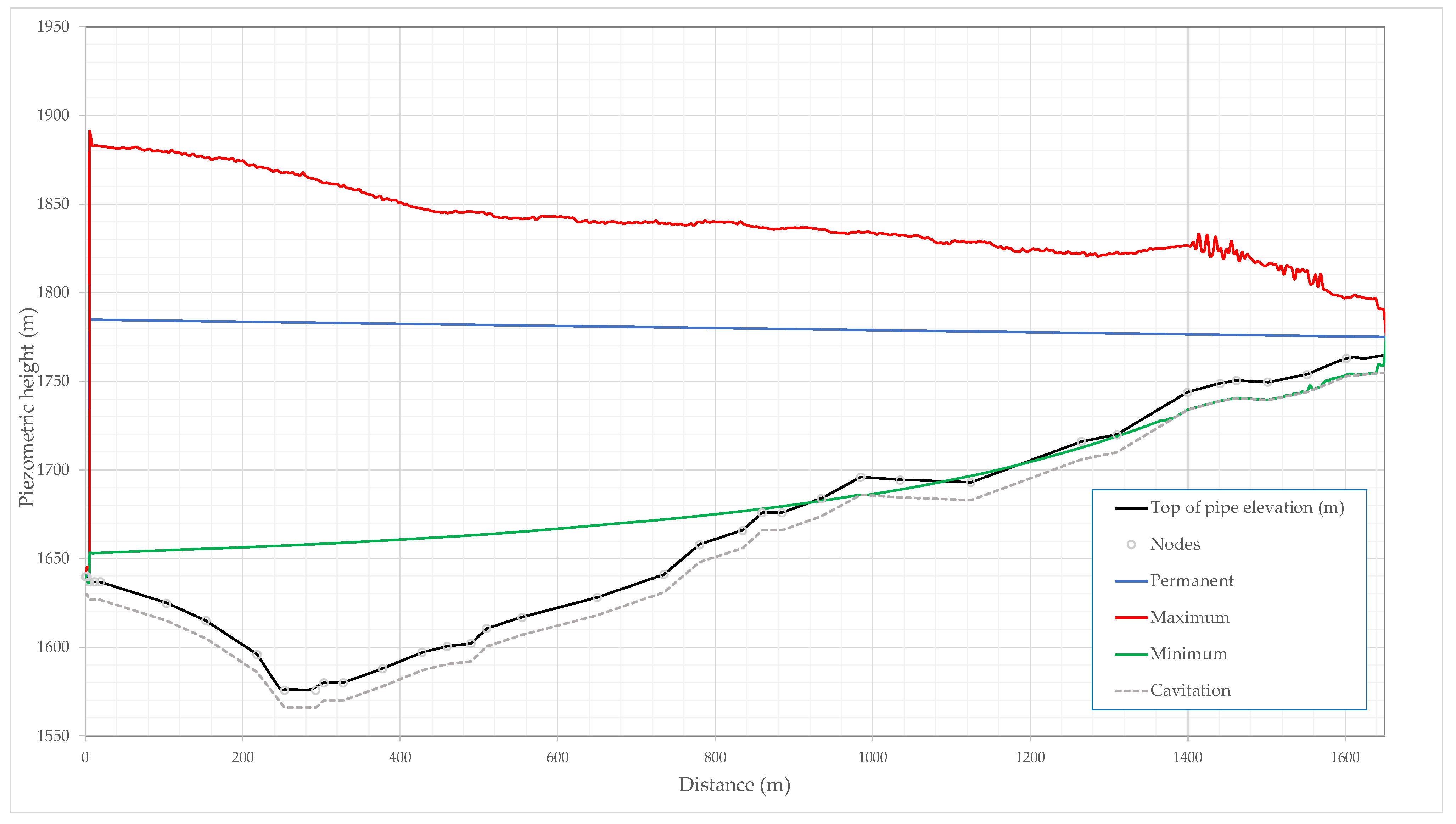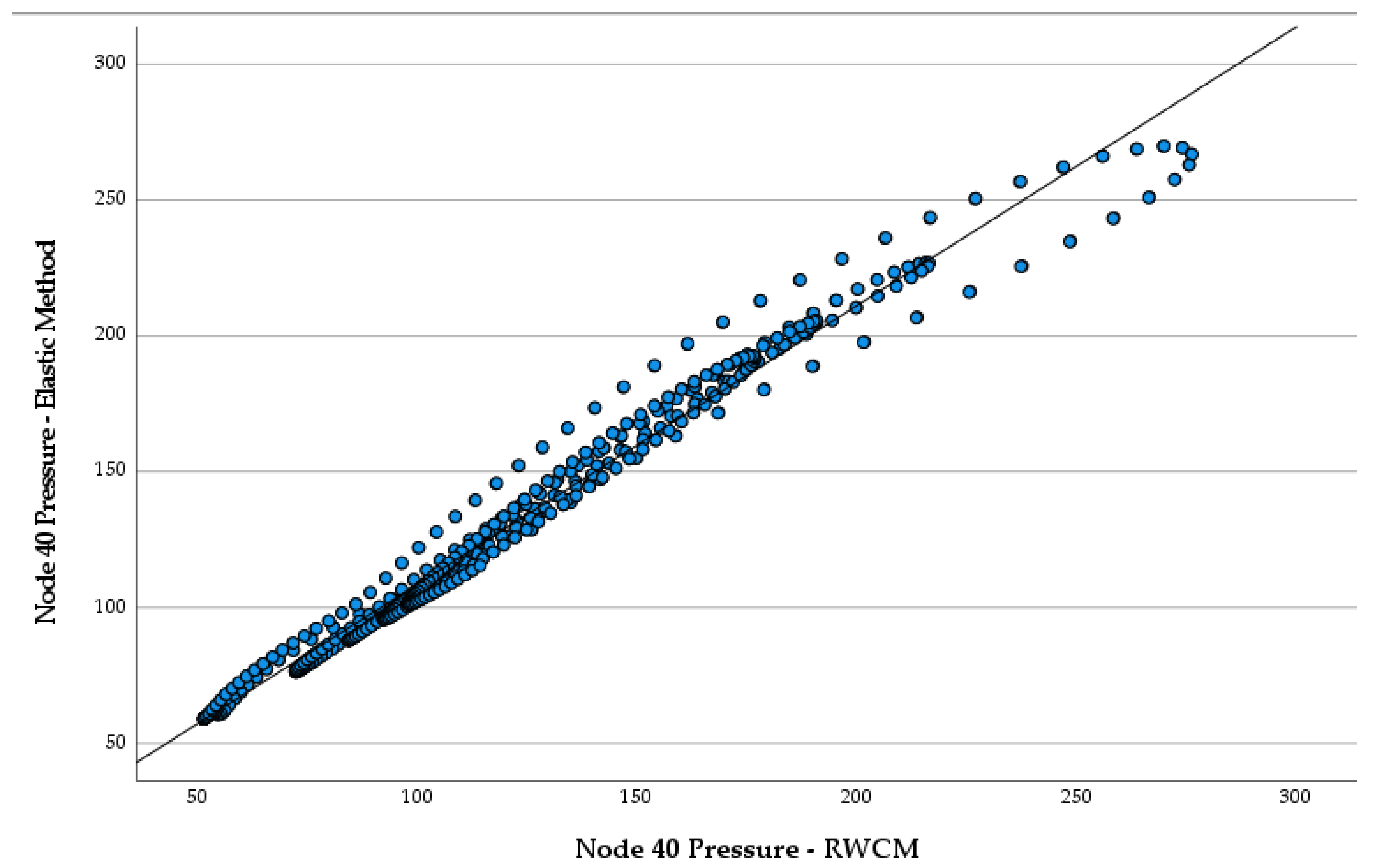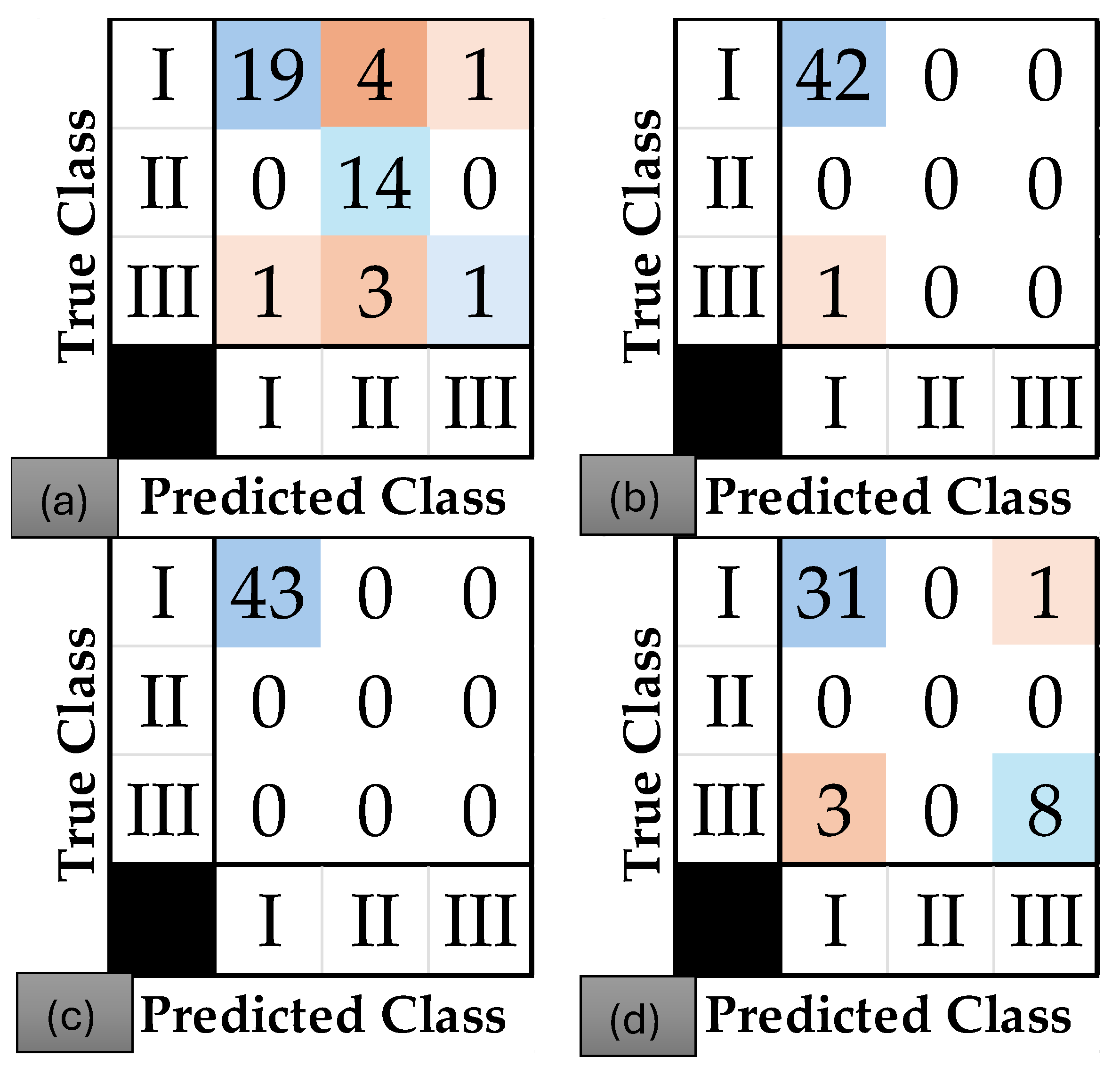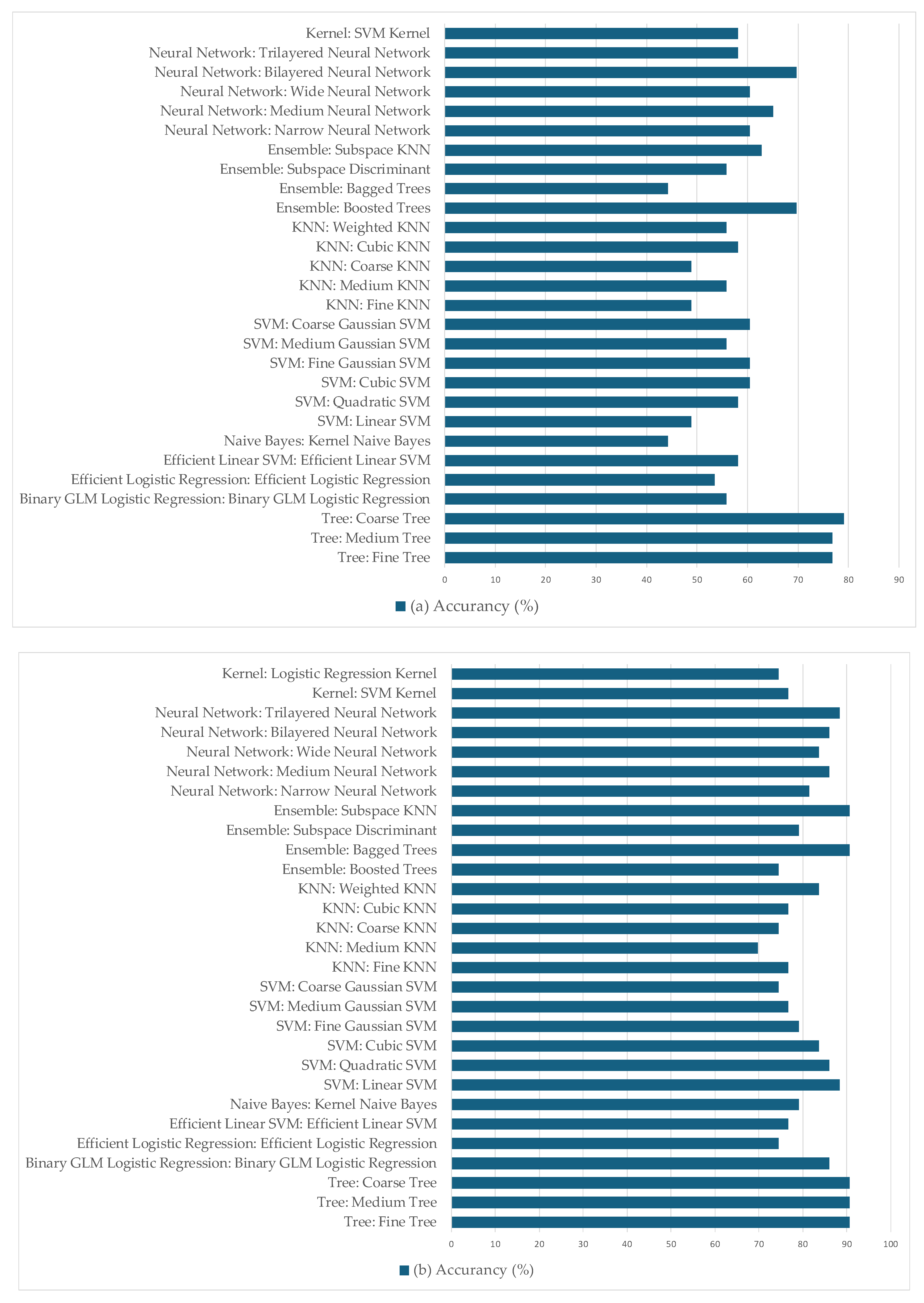1. Introduction
Several strategies can protect hydraulic systems from water hammers, including designing components to endure transient conditions, installing protection devices like surge tanks or hydro-pneumatic tanks (HPTs), and modifying pipeline materials to resist pressure-induced mechanical stress [
1]. HPTs are among the most widely used devices for mitigating pressure surges, alongside other solutions such as flywheels, air valves, and pipeline design adjustments.
The distribution and management of water as an essential resource for human development necessitate the creation of systems and components that ensure its delivery to populated areas and regions where it is required. These systems should comply with minimum performance indicators [
2] such as those established in the Manual of Best Practice-Performance Indicators for Water Supply Services, particularly in aspects like Pressure (QS10) and Service Continuity (QS12).
Ensuring that water reached its destination, whether for human consumption or agricultural irrigation, led to the development of knowledge about water flow based on traditional techniques passed down through generations. It was only with the advent of more in-depth analyses, driven by the development of the scientific method, that discussions emerged regarding the effects of transporting water from one point to another.
One such set of phenomena is hydraulic transients, commonly referred to as water hammers. These occur when there is a sudden change in the velocity of a fluid within pipelines. Such events can cause significant damage to hydraulic infrastructure and adversely affect water service quality, for instance, due to low or negative pressures in pipelines [
3,
4]; service interruptions in hydroelectric plants linked to water contamination [
3,
4]; system vulnerability to transients and their relationship with contamination [
5]; contamination events over multiple years and cities associated with water hammers, as documented by studies in the United States [
6]; low pressure caused by system failures, which correlates with intestinal illnesses [
7]; and failures from pressure drops and water hammer phenomena caused by the operation of pumping systems [
8]. These issues highlight the importance of detailed analysis and accurate modelling. Depending on the rate of change in the defining flow parameters, three types of transients can be distinguished [
9], each with specific characteristics and associated with inertial or non-inertial models (see
Figure 1).
The evolution of hydraulic transient analysis can be divided into two main periods. From 1687 to the early 20th century, the first stage marks the foundation of transient flow theory. Newton (1678) [
10] analysed acoustic wave propagation, while Euler (1759) [
11] and Lagrange (1788) [
12] advanced differential equations and potential velocity concepts. Monge (1789) [
12,
13] introduced the “method of characteristics,” and Laplace (1808) [
12,
13] refined sound wave velocity using Boyle’s law. Throughout the 19th century, researchers such as Weber (1866) and Korteweg (1878) [
14] explored the effects of pipe elasticity, while Gromeka (1883) [
14] incorporated friction losses into water hammer analysis. Joukowsky (1898–1900) conducted groundbreaking experiments, and Allievi (1903) developed a general transient theory, contributing to hydraulic applications and military engineering [
14].
The second stage, beginning in the early 20th century, integrates computational tools and modern techniques such as artificial intelligence and computational fluid dynamics (CFD). Gibson (1923) introduced a method to measure discharge velocity [
15], while Parmakian (1955) integrated transient analysis with engineering applications in Waterhammer Analysis [
16]. Streeter and Wylie (1967) consolidated the Method of Characteristics for numerical modelling [
17], and Zielke (1968) accounted for transient friction effects [
18]. Later, Chaudhry (1979) incorporated industrial applications, and Bergant (1986–2000) developed the discrete vapour cavity model (DVCM) [
11,
19]. Recent studies have focused on optimising hydraulic system performance, including focuses on transient monitoring (Ghidaoui, 2005) [
13], turbine dynamics in small hydro schemes, as cited by Ramos and Almeida (2010) [
20], and valve closure optimisation using actuators in hydraulic systems considering the transient dynamics and system response to valve operation, as described by Skulovich and Kasyanov (2016) [
21]. Advanced models by Chen (2020) [
22], which address transients in axial-flow pumps during startup, provide valuable insights for transient flow prediction. Yin, Zeng, and Yang (2021) [
23] further refined transient predictions, while Lupa (2022) [
24] and Gagnon (2022) [
24] enhanced the understanding of hydraulic transients in turbines and dams, highlighting the continued evolution of the field.
Figure 2 provides a chronological overview of the key developments in hydraulic transient theory, from early physical observations to the integration of computational tools and modern modelling techniques.
This study evaluates the effectiveness of hydro-pneumatic tanks, particularly under boundary conditions suitable for applying the rigid water column model (RWCM) [
25]. The RWCM significantly reduces computation time compared to more complex approaches [
26], such as the elastic water column model (EWCM), while maintaining acceptable accuracy in specific scenarios. The novelty of this research lies in two complementary contributions: first, a comparative analysis between the RWCM and the elastic model using a practical case involving an HPT; second, the introduction of a structured yet practical multi-criteria methodology for selecting transient simulation software based on the technical and operational characteristics of a system.
Although many hydraulic simulation tools offer advanced transient modules based on the Method of Characteristics or full elastic formulations, these often require fine discretisation and prolonged computation time, making them less practical for early-stage design or routine checks. In contrast, the RWCM offers a valuable balance between simplicity and reliability under specific boundary conditions [
27], particularly in systems with slow transients or where elastic effects are of secondary importance. However, the wide range of available software with different numerical schemes and physical assumptions complicates the selection process [
28]. This calls for a structured approach, such as a multi-criteria assessment framework, which goes beyond trial-and-error or preferences based solely on familiarity or availability.
Throughout the twentieth century, the evolution of transient flow theories led to the development of multiple approaches with varying levels of complexity and fidelity. This methodological diversity has given rise to a broad ecosystem of simulation software, each designed for specific purposes, operating under particular assumptions, and subject to inherent limitations. In light of this diversity, incorporating multi-criteria analysis into the software selection process becomes essential, allowing engineers to objectively evaluate the available tools based on technical, operational, and practical parameters.
The recent literature emphasises that the proper selection of simulation software is as critical as the choice of the physical model itself, as it directly affects the accuracy of the results, their interpretability, and the overall design efficiency (Ghidaoui et al., 2005 [
13]; Wylie and Streeter, 1993 [
17]). Several studies have shown that errors in the selection of the simulation environment can lead to increased costs, overdesign, or even operational failures due to underestimation of pressure (Kendir et al., 2013 [
29]).
Multi-criteria analyses enable the evaluation of simulation software across a wide range of dimensions, such as ease of implementation, availability of technical support, model fidelity, capability to represent complex topographies, integration with water quality modules, and flexibility to include special protection devices (Rojas [
30], Amaral [
28]). These criteria become particularly relevant when time, resources, or previous experience with a specific tool are limited, compelling professionals to prioritise certain aspects over others.
Furthermore, it is equally important to investigate the conceptual boundary between full models and their simplified expressions. For instance, the RWCM, commonly employed in the preliminary design of air chambers or relief valves, may yield reasonable results for slow transients and simple geometries. However, its indiscriminate use in complex networks or in cases with rapidly changing pressures may prove inadequate ([
11,
31]).
In this context, the present study proposes a straightforward yet well-founded methodology to guide the selection of simulation software based on six technical and operational criteria. This contribution facilitates informed decision-making and encourages broader discussion regarding the validity conditions of each method, their simplified counterparts, and the software’s ability to represent them faithfully. Finally, this research analyses the implementation of classification learner algorithms (machine learning) to detect if a hydraulic installation can fail depending on initial operational conditions (hydro-pneumatic tank (HPT) volume, water level in reservoirs, and pump characteristics). To this end, 57 scenarios have been assessed.
This research aims to compare the rigid and elastic water column models applied to using HPTs to prevent water hammer in single-phase fluid systems. This analysis is performed through a multi-criteria decision-making approach using simulation tools. Furthermore, machine learning techniques are applied to the simulation results to support the digital transformation currently being implemented by water utilities in distribution systems. The aim is to develop a decision-support tool that enables users to quickly assess whether a hydraulic installation is at risk of failure under given initial operating conditions.
The structure of this article is as follows:
Section 2 describes the protection devices used to prevent dangerous water hammer events in water distribution systems. It presents the mathematical models employed to simulate the water hammer phenomenon using both the rigid and elastic water column theories, outlines the methodology for selecting appropriate simulation software, compares various one-dimensional water hammer models, and introduces current machine learning techniques that can be used for classification tasks within hydraulic system analysis. The Results Section provides a comparative analysis of the outputs from the rigid and elastic water column models. Additionally, it introduces the application of machine learning algorithms as a practical tool to help users rapidly evaluate the likelihood of failure in hydraulic installations. Finally, the Discussion Section explores the practical implications of the findings and their relevance for the design and operation of water distribution systems.
2. Materials and Methods
This section presents the methodological framework developed to address the use of the rigid water column model (RWCM) in the analysis of protected pressurised piping systems. As a first step, the approach includes a literature-supported diagnostic overview of typical protection systems, the risks associated with their absence, and the most commonly adopted protection strategies. This context provides the basis for focusing on HPTs and the evaluation methods applied, with particular emphasis on the RWCM, as illustrated in
Figure 3.
While hydraulic systems should ideally be designed to minimise transient pressure issues, topographical and operational constraints often necessitate incorporating protection systems. These strategies typically involve optimising network operation, installing protective devices, and modifying pipe properties to mitigate hydraulic transients. This paper concentrates on protective mechanisms, particularly the most widely employed types and their sizing methodologies.
Reference [
32] proposed an approximate graphical method for water hammer analysis, considering the inclusion of compensation tanks and air chambers within pumping stations. Reference [
17] described methods such as air purging, pipe geometry alterations, and flexible hoses to decrease wave velocity. Protection systems are divided into direct and indirect action types [
9]. Direct action devices, such as flywheels, check valves, and programmed closure valves, operate immediately upon the onset of a transient. In contrast, indirect action devices are activated as required, including air chimneys, one-way tanks, HPTs, bypass systems, air valves, relief valves, and pressure-regulating valves. Reference [
33] presented a comparative table of key attributes and decision variables for several of these devices, although flywheels were notably absent.
Figure 4 shows a conceptual tree derived from a broad literature review, highlighting the classification of protection systems by device type and their associated functions.
Figure 4 summarises the main protection systems against water hammer events, outlining their characteristics and operating principles. Additional active protection elements not previously addressed include a system proposed by Reference [
34], involving the insertion of a 6 mm rubber hose inside a 53 mm steel pipe, fixed by welding mounting rings every metre. This configuration aims to modify system response frequencies and absorb pressure waves generated by abrupt valve closures downstream. Reference [
35] explored the influence of the viscoelastic behaviour of polyethene pipes on transient phenomena, based on experimental investigations. Nonetheless, the present work focuses primarily on protection systems directly connected to the network.
This section addresses the dangers of a lack of protection systems against water hammers in water distribution networks. Reference [
36] mentioned that activating valves and pumps in a system can lead to system shutdowns or abrupt closures, which increase the risks of hydraulic transients. Reference [
37] described how incorrect valve operations at a power plant caused water service interruptions in Farmington Hills. In addition to damage to the network, a lack of protection can affect water quality by allowing the intrusion of pathogens due to low pressures, as evidenced in the study included in Reference [
38]. Cases such as Tajikistan (1997), Montreal (Canada), and New York [
3] show that hydraulic transients associated with low water pressure have led to disease outbreaks due to the contamination of potable water.
In contrast, the effects of uncontrolled abrupt closures in networks are documented in Anton Bergan’s study [
39], where a simultaneous valve closure generated dangerous transients and damage to the network. Furthermore, pressure drop issues that also need to be addressed are highlighted, such as that which occurred in Cat Mountain, Austin, Texas [
8], where hydraulic transients caused pressure drops and affected system efficiency. It is important to note that many incidents related to water hammer are not reported or properly documented, despite existing regulations [
1].
The analysis of surge protection systems has been addressed over several years. Parmakian [
32] introduced classic methods such as the RWCM and EWCM, as well as graphical solutions for air chambers and unidirectional tanks. Reference [
17] introduced methods for transient control, while Reference [
9] highlighted various protection options, including check valves and flywheels. Reference [
40] analysed the use of open tanks and pressure reduction valves. References [
11,
17,
41] provided guidelines for the installation of air valves, while the research defined in References [
11,
25] discussed control elements and compensation systems.
Both unidirectional and bidirectional compensation tanks are standard in hydroelectric systems and water distribution networks. Reference [
42] compared unidirectional tanks and air chambers, while Reference [
29] and other experimental studies showed consistent results using both the RWCM and EWCM. References [
33,
43,
44] performed analyses of compensation systems for hydroelectric plants using both methods. References [
45,
46] provided models for transients in pipelines and the design of compensation tanks.
Reference [
47] proposed a simplified method for designing choked air chambers. I. Abuiziah et al. [
48] analysed transients in pumping systems protected by HPTs, comparing the rigid column and elastic methods. Reference [
49]’s published results with HPTs showed higher pressure surges than without them. Reference [
50] discussed protection systems in a water network, and Reference [
48] used CFD models to analyse an experimental system.
The combination of protection systems optimises results and costs. Reference [
51] used genetic algorithms to optimise designs, while Reference [
52] combined HPTs with flywheels to achieve a balanced response. Other combinations, such as HPTs and a bypass in HDPE pipes, were analysed by Reference [
53]. Reference [
54] compared the hydraulic characteristics of horizontal and vertical tanks in hydroelectric stations. Reference [
51] used neural networks to calculate air volumes in HPTs. Finally, Reference [
1] highlighted the lack of clear standards for surge protection, recommending the use of HPTs based on engineering practice and experience.
Figure 5 presents the distribution of each surge protection system based on the analysis of the previously referenced articles and publications. This analysis highlights that air chambers or HPTs are among the most commonly used and cited elements of surge protection systems.
The highest distribution of use is found for HPTs. A probable reason for this is that these systems protect both overpressures and negative pressures. Furthermore, their design can be as simple as desired or can increase in complexity if the analysis considers air entrapment, a topic that is beyond the scope of this article but has been explored in works such as References [
55,
56,
57]. HPTs are widely used in countries with advanced water distribution infrastructure, particularly in North America, Europe, and Asia. However, other alternatives, such as relief valves, air chambers, and flywheels, also have significant use, depending on cost, operating conditions, and local regulations.
Based on the reviewed literature and documents that develop protection systems based on HPTs, the following section presents the global distribution of this type of protection system.
As indicated in the initial sections of this research, the development of water hammer mathematical models consists of a set of second-order partial differential equations derived from continuity and momentum equations applied to a fluid packet, in this case, water. These equations are referenced in key and classical literature on the water hammer phenomenon (see References [
9,
11,
17]). Below, a summary of the fundamental equations is presented before we discuss the different modelling approaches for their solution. (see
Table 1).
The solution of the previously mentioned fundamental equations requires numerical methods, each with different considerations and constraints and distinct approaches. Below is a summary of the most representative methods, (see
Figure 6) including their characteristics, advantages, disadvantages, and computational time considerations inferred from the consulted references.
Figure 7 analyses the number of articles that develop calculations or case studies, indicating the overall percentage of each method relative to the total.
Table 2 shows the acronyms, descriptions, and references for
Figure 7.
Although the Method of Characteristics (MOC), which is based on the elastic model, is one of the most widely used approaches, the rigid water column model (RWCM), under specific considerations that will be developed later, proves to be an efficient tool for engineering projects. Approximately 20% of the referenced documents (including in combination with the MOC) cite it and highlight its advantages.
Currently, the MOC dominates the market for design software, as it allows for an accurate description of transient phenomena, particularly in cases without any protection mechanisms. However, as shown in
Figure 7, the computational time required by the MOC is significantly higher than that of the RWCM. This difference becomes particularly relevant in project design, which is often constrained by specific design and implementation requirements.
As previously indicated, the Method of Characteristics (MOC) is the most widely used approach for transient flow calculations, offering higher accuracy than the RWCM. However, when boundary conditions are controlled or remain unchanged, the results obtained from RWCM simulations are very similar to those derived from MOC. Zhang, Z. [
25] states that, under certain constraints, both the RWCM and MOC predict pressure rise with comparable accuracy. Similar cases highlight the practical advantages of the RWCM in simulating slow transients and controlled operations, as discussed by Nault and Karney [
27]. Additionally, in hydropower plants experiencing sudden valve closures, the RWCM simplifies problem evaluation, as demonstrated by Samasi and Abraham [
43]. In hydropower plants using surge tanks as a protection mechanism and modelled under RWCM criteria (Bao, Yang [
44]), comparisons with results from the elastic model show similar behaviour when operating under controlled conditions.
However, RWCM adoption for assessing system stability in practical applications should be approached cautiously, as analysed by Zhang and Qiu [
85] and Kendir and Ozdamar [
29]. The latter implemented an experimental model to evaluate different surge tank configurations—several studies further support its applicability. For instance, Martino and Fontana [
31] propose a simplified sizing approach for throttled air chambers. Furthermore, the draining process of a network described by Coronado, Fuertes, Iglesias, and Martínez [
55,
57] applied the RWCM in a system with an HPT and a control valve, showing close agreement between the measured and computed data. The RWCM was also employed by Yu, Zhang, and Hazrati [
81] to assess the interaction effects of overpressure waves in systems with long tunnels and oscillation tanks in hydropower plants. This highlights the need for further research to refine mathematical formulations and define the model’s validity boundaries.
Another relevant application involves pump systems incorporating HPTs. Abuiziah [
82] analyses a case where HPT serve as the primary protection mechanism, comparing the RWCM with the complete elastic theory. The study emphasises the necessity of defining the extent of the constraints in each evaluation approach: should the RWCM be limited to preliminary designs while the elastic method is reserved for complex applications? Answering this question is one of the key objectives of future research, and it serves as a foundation for the present study.
The conditions under which the RWCM produces results comparable to the MOC are common in engineering projects, where engineers often predefine basic transient control elements before modelling the system. This study aims to demonstrate the advantages and applicability of the RWCM for specific cases. To achieve this, it is essential to understand the characteristics that differentiate the MOC from the RWCM and the prerequisites that must be met to ensure reliable results.
The RWCM is a classical and simplified method for analysing hydraulic transients, derived initially from studies on blood flow. It assumes incompressible fluid and rigid pipe walls, neglecting elastic effects and treating pressure wave propagation as instantaneous. This model laid the groundwork for early water hammer theory and remains widely referenced in the academic literature.
In the rigid water column model, the assumption that
leads to
for the continuity equation gives
This implies that
. The momentum equation simplifies to the Euler equation, also known as the mass oscillation equation:
In Equation (1), v represents the flow velocity [m/s] and x the position along the pipeline [m]. The assumption a→∞ implies an instantaneous pressure response, where a is the pressure wave velocity [m/s] and reflects a constant piezometric head H [m] over time t [s]. The simplification leads to a unidirectional, time-dependent flow, represented by Q = Q(t), where Q is the discharge [m3/s].
For comparison purposes, the elastic water column model (EWCM) was used as the reference model in this study, as it accounts for pressure wave propagation and elastic deformation of pipe walls. Its ability to reflect the physical behaviour of hydraulic transients more accurately makes it suitable for benchmarking the results obtained with the simplified RWCM.
The elastic model offers a more realistic representation of pressurised water systems by incorporating pipe wall deformation. It accounts for pipe elasticity and fluid incompressibility, enabling a more accurate simulation of pressure wave propagation, especially in systems with smaller or more flexible pipelines.
Equations and Properties:
The elastic model is based on a flexible medium’s wave equation for pressure transients. The Saint-Venant equations for hydraulic transients describe the fundamental equation incorporating pipe elasticity.
The governing equations are nonlinear partial differential equations with no analytical solution. Therefore, they must be solved using numerical methods, the most widely used Method of Characteristics (MOC).
The continuity equation is given by
where
.
The following is the momentum equation in the elastic model:
In this model, the wave speed (
a) depends on fluid properties, pipe elasticity, and the pipe’s deformability. The wave of celerity is given by
where E is the pipe elasticity modulus kg/mm
2,
is the fluid density in
, e is the pipe wall thickness in mm, K is the fluid’s bulk modulus, and D is the inlet pipe diameter in mm.
The RWCM is a simplified technique for analysing hydraulic transients, instrumental in systems with HPTs. This method assumes that the water column within the pipeline behaves as a rigid mass, meaning that neither the fluid’s compressibility nor the pipe’s elasticity is considered. Below, an analysis of the method is presented in the context of the design and calculation of HPTs [
11,
17,
84]. The RWCM assumes incompressible fluid and inelastic pipes, effectively eliminating the influence of pressure wave celerity and considering uniform fluid motion without wave propagation. It applies to simple systems or short pipelines where transient effects are negligible. In calculating HPTs, the RWCM models their role as pressure dampeners, directly determining gas volume changes using the polytropic equation and enabling the estimation of the minimum required tank volume and the maximum and minimum pressures during transient events.
The selection of appropriate simulation software for hydraulic transient analysis must be systematic in order to ensure technical accuracy and modelling efficiency. In the context of hydraulic engineering, the use of multi-criteria decision analysis (MCDA) methodologies has been increasingly recommended to support complex selection processes [
28,
30].
Although formal MCDA techniques such as the Analytic Hierarchy Process (AHP) and TOPSIS have been widely discussed, their application often requires extensive resources and expertise. For this reason, this study developed a simplified multi-criteria framework based on direct scoring. This approach enables a rapid, technically sound evaluation suitable for practical engineering applications where selecting an adequate simulation tool must align with the specific characteristics of the hydraulic system.
Several widely used simulation programmes were considered, including the following:
ALLIEVI [
86]: Developed by the Universitat Politècnica de València, ALLIEVI is a software for simulating hydraulic transients in pressurised water systems. It allows for the modelling of valve and pump manoeuvres, including pressure-reducing valves and energy recovery elements such as turbines.
Bentley HAMMER [
87]: Bentley HAMMER CONNECT has been extensively used to analyse and design water, wastewater, slurry, and oil systems. It provides comprehensive tools for modelling hydraulic transients and designing protective equipment.
WANDA [
88]: Developed by Deltares, WANDA is advanced water hammer software designed for use by engineers to analyse and design the hydrodynamic behaviour of pipeline systems. It assists clients throughout the complete lifecycle of their pipeline systems.
AFT Impulse [
89]: AFT Impulse is a powerful dynamic simulation tool for modelling water hammer and surge events in piping systems. It offers a flexible platform for simulating various operating conditions and protective measures.
Pipe2012 [
90]: Pipe2012 is a hydraulic transient simulation programme that provides detailed modelling capabilities for pressure surges and flow variations in pipeline systems. It supports the analysis and design of effective control strategies.
A multi-criteria evaluation framework was developed to support selecting the most suitable software for transient analysis. This framework considers the essential characteristics of the hydraulic system, such as the topographic profile, pipeline length, number of protection devices, wave propagation speed, operational complexity, and the time and resources available for the study. Each criterion is divided into defined categories or ranges to facilitate a structured assessment and to enable consistent comparison across different software tools.
Table 3 presents the classification scheme adopted for this evaluation.
To quantify the evaluation, each criterion
i is assigned a weight
wi, representing its relative importance in the case study context. Similarly, each software alternative is scored with
si according to its capacity to address the requirements associated with criterion
i. The total score
S for a given software is calculated using the following weighted sum expression:
where
n is the number of evaluation criteria;
∈ [0, 1], with ∑
= 1, represents the weight assigned to criterion
i; and
∈ {1, 3, 5}, representing the score given to the software for criterion according to
i, according to its suitability for systems with low, moderate, or high complexity, respectively.
Each programme is scored on how effectively it can manage systems of varying complexity: 5 indicates the programme handles highly complex cases well, 3 suggests moderate capability, and 1 means the programme is only suitable for simple cases or requires significant effort to handle more complicated scenarios.
This scoring system enables a semi-quantitative comparison of different tools while maintaining a technically grounded basis for evaluation. For instance, a tool that excels in modelling wave speed and complex topographies but scores lower on usability may still be favoured in technically demanding scenarios.
The classification ranges (see
Table 3) and the corresponding weights
wi are adaptable and should be refined according to each case’s objectives and operational constraints. This flexible structure ensures the method’s relevance across various real-world conditions, from basic gravity-fed pipelines to pressurised networks with multiple protection devices.
Moreover, this quantitative formulation allows for sensitivity analyses. By adjusting the weight distribution, decision-makers can assess how each criterion influences the final ranking and identify which factors have the most significant impact on the selection of the simulation tool.
The proposed methodology introduces a structured and technically sound framework for selecting the most appropriate software for transient hydraulic analysis, adapted to the physical and operational characteristics of the system under study. The process begins with identifying critical parameters such as the topography, pipe length, presence and type of protection devices, wave propagation speed, operational complexity, and available resources. These parameters serve as inputs to classify the system’s complexity and establish evaluation criteria. Each software option is subsequently assessed for its modelling capabilities, including implementing numerical approaches like the Method of Characteristics and the RWCM, the capacity to manage complex boundary conditions, user experience, and flexibility for customisation. A decision matrix is then constructed, combining performance scores with criterion-specific weights to obtain a semi-quantitative ranking of the available alternatives.
This matrix and the complexity analysis define the required level of modelling detail. If the system can be sufficiently represented by a simplified approximation, such as the RWCM, priority may be given to platforms that allow for faster deployment and analysis. However, more detailed modelling through elastic approaches becomes necessary when the system exhibits rapid transients, intricate control strategies, or highly interactive components. The final software selection is based on identifying the tool that best satisfies both the technical requirements and the practical constraints of the project. This selection ensures a coherent match between system complexity, simulation depth, and the demonstrated capabilities of the software, enabling accurate and efficient transient behaviour analysis.
While the initial objective was to compare the performance of the EWCM and RWCM through a representative case study, it soon became evident that a preliminary analysis of the available software tools was necessary to ensure the proper implementation of both modelling approaches. To this end, a multi-criteria evaluation matrix was developed to systematically assess various software options in terms of their technical capabilities, modelling flexibility, and suitability for different levels of system complexity.
2.1. Methodological Steps for Simulation Comparison
The comparison between the two modelling approaches was carried out using a structured methodology comprising the following stages:
To comprehensively capture the transient dynamics of the selected hydraulic network, both the EWCM and RWCM were employed, as informed by a detailed preliminary system analysis. The EWCM, implemented via the Method of Characteristics (MOC), integrates fluid compressibility and pipe wall elasticity, enabling the high-fidelity simulation of rapid transient events. In contrast, the RWCM adopts a simplified approach by assuming a non-deformable water column, offering a computationally efficient alternative. The simultaneous application of both models to a standard system under identical boundaries and initial conditions enables a novel comparative framework. This dual-model strategy enhances understandings of the trade-offs between computational cost and model accuracy. It provides critical insights into the practical selection of transient modelling approaches for real-world hydraulic systems.
A case study was configured in ALLIEVI software version 3.0.0 (see Step IV, involving the application of a multi-criteria decision matrix) to emulate a representative water supply network, incorporating system characteristics detailed in
Table 3. Model input parameters—including wave speed, initial pressure and flow conditions, tank geometry, and air-to-water ratios—were derived from real operational datasets and technical documentation, ensuring realistic simulation conditions. Within the ALLIEVI environment, two distinct simulation models were constructed: (i) an advanced transient model based on the elastic model using the Method of Characteristics (MOC); (ii) a simplified model employing the RWCM.
To complement the hydraulic simulations and rigorously assess the approximation fidelity between the two modelling approaches, a statistical validation framework was implemented using IBM SPSS Statistics 27 (IBM Corp., Armonk, NY, USA, 2020). A paired samples t-test was applied to compare pressure and velocity outputs from both models. The analysis included computation of mean differences, statistical significance (
p-values), effect sizes (Cohen’s d), and Pearson correlation coefficients to quantify the degree of linear association (Cohen, 1988) [
91,
92]. A significance level of
p < 0.05 was used, and effect sizes were interpreted as small (d = 0.2), medium (d = 0.5), and large (d = 0.8), following established guidelines. This dual-model and statistical integration represents a novel and robust methodology for evaluating transient simulation strategies, providing key insights into the trade-offs between model complexity, computational efficiency, and predictive accuracy in real-world water distribution systems.
2.2. Machine Learning Classification
This section aims to assess whether machine learning algorithms can serve as practical decision-making tools for determining initial operational conditions, specifically, the volume of the HPT, reservoir water levels, and the characteristics of pump curves. If water utilities intend to modify these conditions, the hydraulic system must remain safe, avoiding dangerous pressure extremes. To evaluate pressure surges, three categorical classes were defined: (i) Class I (Normal Conditions): Service pressure remains below 65% of the material’s creep resistance, corresponding to ideal operational conditions. (ii) Class II (Intermediate Conditions): Service pressure ranges between 65% and 99% of the material’s creep resistance. (iii) Class III (Exceeding Creep Resistance): Service pressure exceeds the recommended limits defined in technical catalogues, potentially causing pipeline failure due to surpassing the material’s creep resistance.
A similar classification criterion was applied for sub-atmospheric conditions. The three categorical classes were as follows: (i) Class I (Normal Conditions): Service pressure is less than 70% of the pipeline’s collapse pressure. (ii) Class II (Intermediate Conditions): Service pressure ranges between 70% and 99% of the collapse pressure. (iii) Class III (Collapse Conditions): Service pressure exceeds the material’s structural limit, potentially resulting in pipeline collapse. Several classification algorithms were tested; among them, the Coarse Tree model yielded the best performance, achieving the highest accuracy scores.
The classification thresholds for pressure levels in the machine learning model were derived from design guidelines for steel pipelines. For maximum pressure, the limits were defined concerning the yield strength of the pipe material, as per the AWWA M11 Manual, API 5L Specification, and Pipeline Rules of Thumb Handbook (McAllister). For minimum pressure, collapse thresholds were established considering stability limits for negative pressures in steel.
3. Results and Discussion
3.1. Case Study
The case study analysed in this work corresponds to a real hydraulic system currently under design. While the physical infrastructure has not yet been built, the simulation parameters are based on the final engineering specifications and operational requirements of the project. This configuration provides a realistic foundation for assessing transient behaviour and evaluating protection strategies in a practical context.
The modelled system is schematised in
Figure 7. It consists of a pipeline segment with a total length of 1646.25 m and an internal diameter of 600 mm, connecting two storage tanks with an elevation difference of 125 m. The first tank is located at an elevation of 1640 m above sea level, while the second is at a bottom elevation of 1765 m above sea level. At the initial point of the system, there is a pumping station composed of three pumps, where two (2) pumps operate in parallel and one (1) serves as a standby unit. The head losses due to friction and fittings associated with the pumping station amount to 1.4 m, while the frictional losses along the pipeline are estimated at 11.29 m. Consequently, the total dynamic head to be overcome by the pumping system is 144.8 m.
The two simulated operational pumps each deliver a flow rate of 0.25 m
3/s, against a dynamic head of 144.8 m, operating at a rotational speed of 1800 rpm, with an expected efficiency of 78%. The pipeline is constructed of steel, with a wall thickness of 8.28 mm and an elasticity modulus of 2.38 × 10
9 Pa, resulting in a calculated wave speed of 1148.08 m/s. The key features of the pipeline profile include an elevated crossing over a water body and critical points prone to negative pressures, as highlighted in
Figure 8. These points must be carefully considered during transient analysis.
Based on the physical configuration and design parameters of the system, the simulation boundary conditions were defined as follows: an upstream discharge condition imposed by the pump station (0.5 m3/s at 144.8 m of dynamic head) and a downstream condition governed by a gravity-driven outlet to a storage tank at 1765 m elevation. The system was initially simulated under steady-state conditions, and the transient was triggered by a sudden pump shutdown. A check valve with a closing time shorter than 2 L/a (estimated at 2.87 s) was considered. These boundary conditions were applied consistently in both the RWCM and EWCM simulations to ensure a fair comparative assessment of pressure and velocity responses.
3.2. Multi-Criteria Software Selection
A structured multi-criteria evaluation identified the most appropriate simulation software for modelling a real hydraulic system, incorporating six critical parameters: topographic complexity, total pipe length, number of protection devices, wave propagation speed, operational complexity, and resource availability. Each parameter was normalised and scored on a standardised scale to reflect varying degrees of system complexity. The performance and capabilities of five leading transient simulation tools—ALLIEVI, (Version 3.0.0), HAMMER (Version 24.00.00.xx (2024), by Bentley Systems), WANDA (Version 4.7.x (2024), by Deltares), AFT Impulse (Version 10 (2023), by Applied Flow Technology), and Pipe2012 (Version 12.009b (latest available)—were then systematically assessed against these criteria.
Software scores were assigned based on each tool’s ability to handle the defined system requirements, enabling a transparent comparison of their suitability under different operating scenarios. The selection process culminated in identifying the optimal match between system demands and software capabilities, as summarised in
Table 4. This evidence-based selection framework introduces a novel and reproducible methodology for aligning hydraulic modelling tools with the specific challenges of complex water infrastructure systems.
The analysis revealed that parameters such as wave propagation speed and operational complexity critically influence the selection of simulation software, emphasising the need for tools with high configurability in defining dynamic boundary conditions to ensure accurate transient flow representation. A comparative assessment of each program’s performance under the specified system conditions confirmed notable differences in responsiveness and modelling precision. Tools offering advanced customisation options and robust numerical solvers demonstrated superior adaptability to complex operational scenarios, highlighting their suitability for systems characterised by rapid transients and variable boundary inputs. These results provide a clear rationale for prioritising simulation platforms that balance computational efficiency with the ability to replicate real-world hydraulic dynamics (see
Table 5).
A brief analysis of the evaluation results reveals several relevant observations. Unlike HAMMER, ALLIEVI stands out for its ability to manage complex topographic profiles without manual discretisation. Regarding pipeline length, all software packages perform well over medium distances (1–5 km), although Pipe2012 shows slight limitations. Regarding the modelling of protection devices, flexibility is critical, and again, Pipe2012 proves to be more basic than the other tools. For systems with high wave speeds (>1000 m/s), ALLIEVI, WANDA, and AFT Impulse provide direct support, whereas HAMMER requires specific adjustments. Regarding operational complexity, ALLIEVI, WANDA, and AFT Impulse offer superior capabilities for handling sophisticated pumping station configurations, while HAMMER demands additional setup efforts. Finally, considering time and resource constraints, ALLIEVI is highlighted by its free access and rapid modelling capabilities, whereas HAMMER, WANDA, and AFT Impulse require costly licences and longer implementation times.
Based on the results presented in the comparative evaluation, ALLIEVI was selected to develop the modelling work. This decision was justified by its capacity to manage complex hydraulic profiles without needing manual discretisation, its flexibility in incorporating components such as HPTs, and its native support for high wave speed values. Moreover, ALLIEVI demonstrated superior performance in handling systems with multiple pumping stations, offering the advantage of being a free and efficient tool. Consequently, ALLIEVI was considered to fully satisfy the technical requirements of the study, thereby supporting the modelling undertaken.
3.3. A Description of the Systems Modelled Using the Chosen Software—Comparison of Results: Elastic vs. RWCM Method
The input data is described in this section. Under these conditions, an initial analysis of the system’s behaviour was conducted in response to an abrupt shutdown of the pumping system, without any protection elements in place. The evaluation of this scenario (see
Figure 9), along with those explained later, was carried out using the ALLIEVI 3.0.0 software, processing the data on a computer with the following specifications: processor: Intel(R) Core(TM) i7-4700MQ CPU @ 2.40GHz, 2401 MHz, four main processors, eight logical processors; installed physical memory (RAM): 12.0 GB. The equipment used was a Toshiba Satellite P55t-A laptop, manufactured by Toshiba Corporation, Tokyo, Japan, and operated with Microsoft Windows 11 Pro, developed by Microsoft Corporation, Redmond, WA, USA.
In this initial system evaluation by the RWCM method, the computation process took 102 s. Below, data at Node N40—located downstream of the pumping system—are presented, along with the velocities in pipe T37, which reaches this node (see
Figure 10).
The system generally exhibits oscillations, with overpressures at the beginning of the pipeline and two sections with negative pressures that cause cavitation in the network.
Figure 11 illustrates the system’s overall behaviour under sudden pump shutdown conditions, which was simulated by stopping the pump 5 s after startup.
To improve the network’s performance and prevent system oscillations and negative pressures, an HPT with a total volume of 8 m
3 was proposed. The tank is installed at the head of the pressurised pipeline, immediately downstream of the pump outlet, ensuring optimal placement for transient suppression. It is assumed that when the pumps shut down, both units will be operating, and the check valves will close in a time shorter than 2 L/a, corresponding to 2.87 s, generating the previously observed overpressures. The initial compressed air volume is 3.09 m
3, resulting in a 70/30 water-to-air ratio, with a minimum initial pressure of 55 m. This configuration is consistent with standard practices in transient mitigation design (see
Figure 12).
Under this new configuration, the calculation process took 111 s. The following presents the pressure behaviour at N40 and the velocity in pipe T37 (
Figure 13).
The HPT generates a wave attenuation effect that prevents the formation of zones with negative pressures and ensures a more gradual overpressure behaviour in the system (see
Figure 14).
To estimate system behaviour using the RWCM modelling approach in ALLIEVI, the wave speed was intentionally increased to simulate reduced system elasticity while maintaining the original hydraulic configuration. In this setup, the wave speed was elevated to eight times its initial value, reaching 9185 m/s, thereby approximating the conditions of a rigid column within the same network topology. Although this value does not correspond to any real pipe–fluid configuration, it serves as a numerical strategy to suppress wave propagation and simulate the assumptions of the RWCM. This technique is common among practitioners when rigid modelling is required in environments where zero wave speed cannot be implemented. This simplification enabled a significant reduction in computational time, with the model completing its calculations in just 27 s, which was 24.55% faster than the simulation using the elastic model. The results, illustrated in
Figure 15, show the pressure and velocity profiles obtained from both approaches, revealing a strong resemblance in the general transient behaviour, thus validating the rigid model as a computationally efficient alternative for scenarios requiring rapid assessments without a substantial loss of fidelity.
Initial modelling was conducted to identify potential issues in the system based on the configuration considerations outlined. From this first model, developed using the ALLIEVI software (elastic model), the HPT was defined as the primary—and in this case, sole—protection mechanism. The areas that initially exhibited low-pressure conditions experienced a reduction in such occurrences, while the pressure surge wave was gradually attenuated. The main objective of this analysis was to assess the behaviour of the solution and the results obtained through modelling using both the elastic method and the simplification presented by the RWCM.
The pressure and velocity values plotted in
Figure 15 show a correlation of 97.8% for pressure data and 98.5% for velocity data, demonstrating high reliability for the results obtained under the RWCM simplification. However, let us examine the results in detail to identify critical points that require special attention. In general, the solutions obtained by both methods exhibit similar behaviour. However, it is essential to note that during the first 5 s of the simulation, before the pump shutdown occurs, pressure and velocity variations of approximately 5% to 8% are observed, respectively. As time progresses, a shift in the velocity curves of the rigid column model becomes noticeable. Nevertheless, after approximately 35 s, the velocity curves stabilise, maintaining a variation range of 4% to 6%. Pressure data, however, exhibit greater variation, reaching differences of 18% to 20% at specific points. Despite these variations, the overall trend and representativeness of the results remain consistent.
The system evaluation using the elastic method in ALLIEVI (based on the Method of Characteristics) took 110 s, whereas the simplified approach required only 27 s. This significant reduction in computational time is a key factor to consider when making design or evaluation decisions, further justifying the simplified method presented in this study. These results provide a direct comparison between the two approaches and serve as a foundation for our subsequent discussions on computational efficiency and the applicability of each method in operational contexts.
The analysis presented provides a comparative evaluation of a system with water hammer protection using two different methods: the elastic method, which enables a comprehensive analysis of the entire system and should be used before any protection system is implemented, and the RWCM, which neglects the elastic properties of both the materials and the water, under the assumption that an existing protection device compensates for pressure wave fluctuations caused by a sudden pump shutdown. Using the RWCM for initial assessments is not highly recommended, as its simplifications lead to the loss of critical information regarding potential low-pressure points that must be considered in the system’s design. The following figures (see
Figure 16) illustrate the general system layout without protection under both methodologies, highlighting that the simplified approach does not fully capture all the potential issues within the network.
These results confirm that the RWCM is inadequate for systems without protective devices, as it fails to represent the dynamic behaviour caused by rapid pressure waves. However, when protective elements such as HPTs are present, they act as dampeners, reducing pressure fluctuations and aligning system behaviour with the assumptions of the rigid water column model. Therefore, the RWCM is only valid when applied to protected systems where transients are naturally smoothed by design.
Regarding the evaluation, when a protection system is in place, such as an HPT, the results show an excellent approximation while achieving significant computational time savings. This suggests that such simplifications could be effectively used for decision-making or obtaining key operational parameters in the daily management of a water supply network.
A statistical analysis was performed using the SPSS software to validate the approximation quality further. A paired samples
t-test was conducted comparing the results obtained with the elastic and rigid column methods (see
Figure 17). The mean difference for pressure at Node N40 was 9.13 m, with a t-statistic of 37.826 and a
p-value < 0.001, indicating a statistically significant difference. The effect size (Cohen’s d = 1.257) confirmed a considerable practical significance. In contrast, for the velocity at T37, the mean difference was −0.0137 m/s, with a t-statistic of −3.100 and a
p-value of 0.002, showing a statistically significant but practically negligible difference (Cohen’s d = −0.103).
The paired samples correlations were 0.989 for pressure and 0.991 for velocity, both highly significant (p < 0.001), highlighting the strong consistency between the two methods. These results confirm that the rigid column approach provides sufficiently accurate predictions for velocities while underestimating peak pressures, an aspect that should be considered when using simplified models for critical design or analysis purposes.
Finally, using the rigid and elastic water column models, the confusion matrix was applied to 57 scenarios generated from ALLIEVI simulations.
Table 6 presents the initial operational conditions of the hydraulic installations that were varied to assess whether the machine learning techniques could capture the effects of these variations.
3.4. Machine Learning Approximation
The dataset used for training and testing the classifiers consisted of 57 simulated scenarios generated using the ALLIEVI software. These cases were systematically constructed based on engineering criteria, covering both standard and extreme operating conditions, including maximum and minimum pressures and various tank volumes. The system under analysis was a real configuration that had not yet been built; therefore, scenario boundaries were defined based on the actual design constraints, such as the installation level of the tank, maximum tank volume, operational water levels, and pump flow rates. These parameters were varied within logical bounds applicable to the case study while ensuring sufficient variability to enable meaningful analysis under the proposed conditions.
Prior to model training, all input features (e.g., tank volume, pipe length, air pressure) were normalised using the Min-Max method to rescale values between 0 and 1. This preprocessing step ensures the balanced influence of variables during classification and reduces potential bias arising from differing units and scales.
The Coarse Tree algorithm was selected for the analysis in MATLAB 2024b, as it achieved the highest accuracy when compared to other available classifiers (Discriminant Analysis, Naïve Bayes, Support Vector Machines, Linear Efficient, KNN, Kernel, Ensemble Methods, and neural networks).
Table 7 presents the classification accuracy obtained using both the rigid and elastic water column models, focusing on extreme pressure peaks at Node N10 and sub-atmospheric pressure oscillations at Node N34. The Coarse Tree model was validated using 25% of the dataset. The best accuracy results were obtained with the elastic model, ranging from 90.7% to 100.0%. In contrast, the accuracy values obtained with the rigid model correspond to scenarios where the model assumptions were no longer valid (i.e., in the absence of a functioning HPT), as the simulated pressure peaks exceed physically realistic limits.
The classification thresholds for pressure levels in the machine learning model were derived from design guidelines for steel pipelines. For maximum pressure, the limits were defined concerning the yield strength of the pipe material, as per the AWWA M11 Manual, API 5L Specification, and Pipeline Rules of Thumb Handbook (McAllister). For minimum pressure, collapse thresholds were established considering the stability limits for negative pressures in steel. The defined classes are as follows:
- -
Class I (Normal): Pressures below 65–70% of the material limit;
- -
Class II (Potential risk): Pressures between 70 and 99% of the yield or collapse value;
- -
Class III (Failure): Pressures at or above the material limit.
These thresholds were used to label the training data for classification purposes.
Figure 18 shows the confusion matrix results for the rigid and elastic water column models. For pressure surges, the classification includes Class I (Normal Conditions), Class II (Intermediate Conditions), and Class III (Exceeding Creep Resistance). In contrast, for negative-pressure conditions, the categories are Class I (Normal Conditions), Class II (Intermediate Conditions), and Class III (Collapse Conditions). The definitions of these classes are provided in
Section 2.2.
The values highlighted in blue indicate that the model can reliably predict whether the pipeline will remain safe under the specified initial operational conditions. Most inaccuracies occur when using the rigid water column model for pressure surge analysis, as this model fails to capture the physical phenomena accurately, particularly in scenarios lacking a protection device, such as an HPT.
Overall, the results confirm that machine learning techniques can effectively support water utilities in quickly assessing whether changes to operational conditions may lead to pipeline failure due to overpressures or sub-atmospheric conditions.
To evaluate the most suitable classification approach, multiple supervised learning models were tested, including Tree, Discriminant Analysis, Naïve Bayes, Support Vector Machines (SVMs), k-nearest neighbour (KNN), Ensemble Methods, and neural networks. All the models were trained and validated using a five-fold cross-validation scheme.
The performance of each model varied by scenario. In the case of the elastic model for minimum pressure classification, all models achieved 100% accuracy due to clear class separation. However, in more complex cases, such as predicting surge and sub-atmospheric conditions in rigid models, the Coarse Tree classifier consistently offered the highest accuracy while maintaining interpretability and low computational cost.
Figure 19 compares the performance of all tested classifiers across the three evaluated scenarios.
All models were trained using 70% of the available data, with the remaining 30% held out as an independent test set. During training, a five-fold cross-validation procedure was applied to evaluate model generalisation and minimise overfitting. This hybrid validation approach provides reliable performance estimates for comparing classifiers under different hydraulic scenarios.
3.5. Sensitivity Analysis of Tank Parameters
Although this study evaluates the performance of hydro-pneumatic tanks (HPTs) in transient mitigation under specific design conditions, it does not include a parametric sensitivity analysis of the tank volume or initial air pressure. These factors are known to influence the pressure-damping effect and response time of the protection system. A quantitative assessment of their impact was not included at this stage but is recognised as a key aspect of future research. Ongoing and future work will address this by evaluating multiple configurations to provide more comprehensive design guidelines for hydro-pneumatic protection systems.
3.6. Study Limitations
This study is based on a real hydraulic configuration that is currently under design, which limits the availability of empirical field data for calibration. While the training data for the machine learning model were generated using the ALLIEVI software, the simulated scenarios were carefully constructed based on engineering judgement and standard hydraulic design criteria. The adopted modelling approach—particularly the use of the rigid water column model (RWCM) and its comparison with the elastic model—was validated through structured simulation and statistical agreement between pressure and velocity results.
However, direct calibration against observed field data remains an important step to reinforce the generalisability of the results. Several studies in the literature have shown that the RWCM can provide reliable estimates when compared to elastic models or experimental data, especially in systems with HPTs. Examples include the validation of simplified models in pressure networks by Kendir and Ozdamar [
29], the optimal sizing of throttled air chambers by De Martino and Fontana [
31], the application of the RWCM in controlled draining procedures by Coronado et al. [
55,
57], and the comparison of rigid and elastic approaches in pumped systems by Abuiziah [
82]. These studies support the technical soundness of the modelling strategy used in this work and serve as a reference for planned future calibration efforts.

